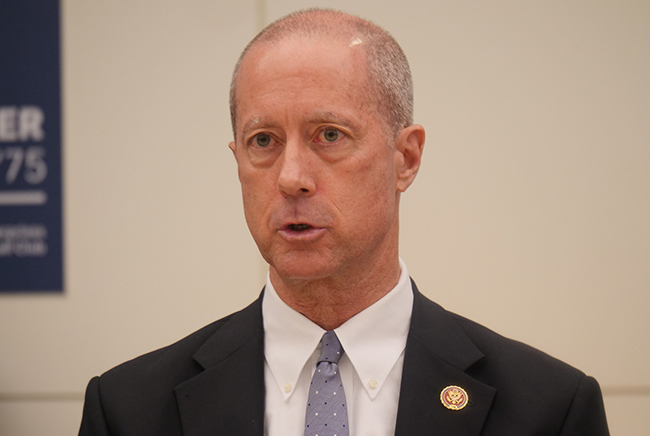
Rep. Mac Thornberry (R-Texas) speaks at a June 11, 2019, Defense Writers Group breakfast. George Washington University School of Media and Public Affairs photo
Rep. Mac Thornberry (R-Texas), the House Armed Services Committee’s top Republican and former chairman, will bring up an amendment this week to raise the panel’s spending recommendation to $750 billion in the 2020 defense policy bill.
The Trump administration requested $750 billion for national security in 2020, including $718.3 billion for the Defense Department. But the Democrat-led HASC recommends $733 billion, one figure the administration reportedly considered earlier in the budget-crafting process. HASC’s topline is split between $725 billion in discretionary spending for national defense and about $69 billion for the overseas contingency operations account.
Thornberry’s amendment aims to give the Trump administration what it asked for in its initial request and unfunded priorities lists, while avoiding controversial items like money to build a barrier at the southern US border. HASC will take up the proposal during markup June 12.
The Texas congressman is concerned that paring back funding would hinder the Pentagon’s ability to continue recovering from the effects of past mandatory cuts. On the other side of the aisle, HASC Chairman Rep. Adam Smith (D-Wash.) told reporters June 10 he’s not convinced by the argument for 3 percent to 5 percent annual growth in the defense budget, saying DOD will always want more and that throwing money at the issues doesn’t encourage fiscal responsibility.
Another 3 percent will help the military take care of its people, buy additional aircraft, pursue hypersonic weapons, replace the Minuteman III, recover Tyndall AFB, Fla., and Offutt AFB, Neb., and more, according to a summary of Thornberry’s amendment. He argues additional funds would support core DOD priorities that can’t be ignored.
At a June 11 Defense Writers Group breakfast, Thornberry said he discussed the 2020 defense budget request at a December 2018 meeting in the Oval Office with Vice President Mike Pence, acting White House Chief of Staff Mick Mulvaney, Office of Management and Budget Deputy Director Russ Vought, National Security Adviser John Bolton, Senate Armed Services Committee Chairman Sen. Jim Inhofe (R-Okla.), and then-Defense Secretary Jim Mattis.
“A number of us made the case that, as [Chairman of the Joint Chiefs of Staff Gen. Joseph] Dunford and Secretary Mattis did in the spring of 2017, that you[‘ve] got to have 3 to 5 percent real growth just to not fall further behind with the Russians and the Chinese and and to build our readiness,” Thornberry said. “At the end of the day, the president’s decision was, OK, we’ll do 3 percent real growth. … He likes round numbers, so that’s how $750 [billion] got there.”
Even as committee leaders tout the panel’s longstanding tradition of passing a bipartisan bill, Thornberry indicated the topline could be a sticking point for Republican members, but he would not say whether a number lower than $750 billion would be cause to vote against it.
The GOP will need to evaluate “the good, the bad, and the ugly in the bill,” he said, hoping markup produces legislation both parties can support.
“If you say, no, we’re not going to fund these things, that’s a big deal,” Thornberry said. “We’ve got amendments to come and go. It may get better, it may get worse. We’ll see. … All Republican members on the committee want to vote yes on this bill. The question of whether we do is going to depend on that basic thing I said a while ago—does this continue to move us forward or does this take us backwards?”
Budget cap rules still threaten to slash defense spending to $576 billion in 2020 if Congress can’t agree to raise defense and non-defense funding levels set by a 2011 law. House and Senate authorizers and appropriators will also hash out their legislative differences over the coming months.